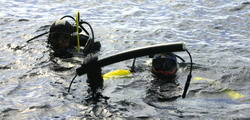Cetaceans consist of all whales, dolphins and porpoises and are divided into toothed whales (odontocetes) and baleen whales (mysticetes). In the research area of Cetacealab we are fortunate to be in the company of both. The orca is a member of the toothed whale suborder and is the largest member of the dolphin family. The humpback whale is a baleen whale.
 For this reason in conjunction with the research facility we have set up a network of hydrophone stations in strategic locations ranging from 3 to 10 km from Cetacealab. Each hydrophone has been placed 60-80 feet underwater, connected via cable to a land- based transmitter. The radio transmitter will broadcast all whale vocalizations back to Cetacealab. All stations are powered with solar panels and 12 volt batteries. We monitor these underwater sounds
For this reason in conjunction with the research facility we have set up a network of hydrophone stations in strategic locations ranging from 3 to 10 km from Cetacealab. Each hydrophone has been placed 60-80 feet underwater, connected via cable to a land- based transmitter. The radio transmitter will broadcast all whale vocalizations back to Cetacealab. All stations are powered with solar panels and 12 volt batteries. We monitor these underwater sounds  continuously in the lab, day and night, all year round. When calls are heard we then begin to record directly onto our computer. From these recordings we can monitor the movement patterns of different Orca populations and Humpback Whales. This method of research is ideal, as we are no longer dependent on weather conditions or daylight. More important, we are able to collect all acoustic information without having an impact on the whales. At present this hydrophone network enables us to listen to an underwater area of 25sq.km. We would like to increase this coverage further to determine how important this particular core habitat is to their continued existence.
continuously in the lab, day and night, all year round. When calls are heard we then begin to record directly onto our computer. From these recordings we can monitor the movement patterns of different Orca populations and Humpback Whales. This method of research is ideal, as we are no longer dependent on weather conditions or daylight. More important, we are able to collect all acoustic information without having an impact on the whales. At present this hydrophone network enables us to listen to an underwater area of 25sq.km. We would like to increase this coverage further to determine how important this particular core habitat is to their continued existence.


